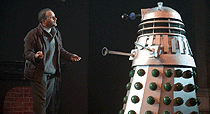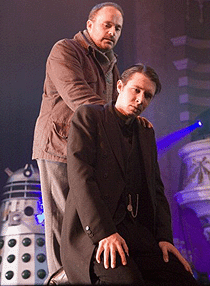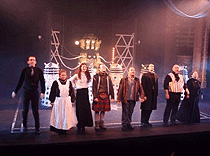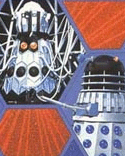| |
The Evil of the Daleks on TV
The Evil of the Daleks was a 1967 Doctor
Who story and is said by most fans to be one of the greatest
adventures on which the time traveler has been.
It has been voted the best Doctor Who story of all
time by readers of DWB and it was voted in at 9th
for Doctor Who Magazine. What makes it such a well-loved
story? The quality of writing, the acting, and the production
are all of a very high standard. But it has much more to it
than that.
To appreciate why it is so good, it must be looked at in context.
The previous story had seen the departure of Ben and Polly,
and with them went the last remnants of the William Hartnell
era. The Evil of the Daleks was the TV show's first
blockbuster season finale and it used all the tricks which
would be seen when The Parting of the Ways paid tribute
to it thirty-seven years later.
The story examines the human race, what makes us weak and
strong and most importantly how the most evil beings in the
universe would exploit it. The Daleks book-end Patrick Troughton's
first season. But whilst they were subjugated and initially
impotent in The Power of the Daleks, their return
in The Evil of the Daleks couldn't be more different.
In The Power of the Daleks, the Doctor was only person
who knew the truth of the situation. In the season finale
this situation is brilliantly turned on its head with The
Doctor being the last person to discover the trouble he is
in. The Daleks this time are totally in control, with their
brainwashed human operatives mixing with men who have been
bribed and blackmailed. Ultimately even the Doctor is forced
to work for them. As the story nears its conclusion the Doctor
jumps out of the frying pan and into the fire, as he ends
up on the Dalek homeworld of Skaro.
At this point, Skaro then became a book-end for the whole
of Doctor Who because it became the first and last
alien world visited by the Doctor. Doctor Who in
1967 was not full of back-references and sequels. After three-dozen
adventures, other than the Daleks, only The Meddling Monk
and the Cybermen had made a return. To rob the Doctor of his
TARDIS, pit him against his oldest foes, and send him back
to where he first met them was a thrilling treat for a fan
of the show.
Then add extra exciting ingredients: It is revealed that the
ruler of the Daleks is a giant Emperor who is hard-wired into
the city. A civil war erupts between two Dalek factions, and
a battle rages the like of which has never been seen before.
The only survivors of the carnage are the Doctor, Jamie and
a new companion, Victoria.
The is one of the few Doctor Who stories which play
out across different times and planets. Shifting the action
from the present day to peaceful Victorian England, and finally
to all-out war in an alien city really does make it epic.
But in addition, the narrative is filled with well-rounded
and interesting characters, all driven by different agendas.
There are some brilliant lines of dialogue and resolution
is both exciting and satisfying.
Aside from a few loose threads left hanging, there isn't a
great deal you could do to make this story any better and
for that reason it really is one of the greatest Doctor
Who adventures. It is perhaps also the greatest tragedy
in the history of the show that this legendary season finale
was wiped by the BBC.
Click here to read
about the TV serial. |
|
The 2006 Stage Show
The
Evil of the Daleks
stage play was a fantastic stage production orchestrated
by a dedicated band of theatre workers and Doctor Who
fans.
Working on a modest budget and performing to packed houses,
this relatively small-scale production created a lasting impression
on the Doctor Who community young and old.
Their desire to bring this story to a new audience was born
out of a love of the old show and the fact that the new series
was revived in 2005, which generated an added impetus to make
a theatre production something which related to the returning
Time Lord.

The idea proved to be a stroke of genius because even though
the two earlier plays of The Web of Fear and Fury
from the Deep had been extremely successful and well
received, the appearance of the Daleks following the second
new TV series generated more interest than ever before. Dalek
fans are like no other breed of Doctor Who fan, almost
an entirely separate entity and Dalek websites soon picked
up on the show, leading to tremendous interest and excitement
in the production.

It performed at the New Theatre Royal, Portsmouth in October
of 2006 and featured Nick Scovell as the Doctor, who also
adapted the script.
Set design, sound effects and Dalek voices were provided by
Rob Thrush who also produced the show.

Changes were made where necessary to the original story in
order to make it fit to the theatre but the ethos of David
Whitaker's original plot remained.
Some characters were removed, some tweaked and some new angles
were added. In all, this stage show was a stunning reworking
or the original and this website is proud to document its
creation.
Click here
to read about the Stage Show.
|
|
Print & Audio
With Target having finally negotiated
the rights to produce a novelisation
of The Evil of the Daleks, John Peel produced the 224
page version which fleshed out both the human and indeed the
Dalek characters.
Peel puts a lot of background information into the theft of
the TARDIS at the start of the story as well as what the Doctor
and Jamie go through to recover it.
The cover for this 1993 publication was provided by veteran
book cover artist Alister Pearson, who also provided art for
The Power of the Daleks published a month earlier.

For those more interested in trying to experience the spoken
word as it was on screen, rather than a writer's interpretation
of it, The Doctor Who Script Project has provided a complete
free transcript
of The Evil of the Daleks.
For the best visual reference to this missing masterpiece,
the BBC website has a complete set of John Cura's telesnaps,
which are photographs of the episode as it happened.
If the telesnaps are viewed whilst accompanied by the audio
soundtrack available from the BBC, then this is the closest
a person can get to experiencing the episode as it was.
Save for a few location shots at Grim's Dyke, plus photos
leading up to the battle in episode seven, very little visual
material exists aside from the telesnaps, so they give an
invaluable insight.
Also available is the surviving episode two, which is available
on the Lost
in Time DVD.
|
|







